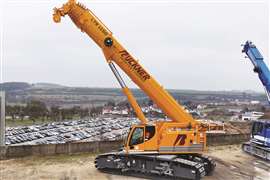Crane crucial to NASA Mars landing
27 July 2012

Early August sees deployment of a rocket powered robot crane to lower NASA's mars rover, called Curiosity, to the surface of the red planet.
In a tough mission the 1 tonne planetary rover is scheduled to land beside a Martian mountain to begin two years of scientific detective work. "The Curiosity landing is the hardest NASA mission ever attempted in the history of robotic planetary exploration," said John Grunsfeld, associate administrator for NASA's Science Mission Directorate, at NASA Headquarters in Washington, USA.
To land the car-sized rover, the air bag method used on previous Mars rovers will not work. Mission engineers at NASA's Jet Propulsion Laboratory (JPL) in Pasadena, California, designed the "sky crane" method for the final several seconds of the flight. A backpack with retro-rockets controlling descent will lower the rover on three nylon cords just before touchdown.
During a critical period lasting only about seven minutes, the Mars Science Laboratory (MSL) spacecraft carrying Curiosity must decelerate from more than 13,000 mph (5,900 metres per second) to allow the rover to land on the surface at about 1.7 mph (0.75 metres per second). Curiosity is scheduled to land in the early morning (Eastern US time) of 6 August.
"Those seven minutes are the most challenging part of this entire mission," said Pete Theisinger, MSL project manager at JPL. "For the landing to succeed, hundreds of events will need to go right, many with split-second timing and all controlled autonomously by the spacecraft. We've done all we can think of to succeed. We expect to get Curiosity safely onto the ground, but there is no guarantee. The risks are real."
After initial test exercises the rover will begin investigating whether an area with a wet history inside Mars' Gale Crater ever has offered an environment favourable for microbial life. "Earlier missions have found that ancient Mars had wet environments," said Michael Meyer, lead scientist for NASA's Mars Program at NASA Headquarters. "Curiosity takes us the next logical step in understanding the potential for life on Mars."
The MSL mission is a precursor to a human mission to Mars. President Obama in the USA set a challenge to reach the red planet in the 2030s.



